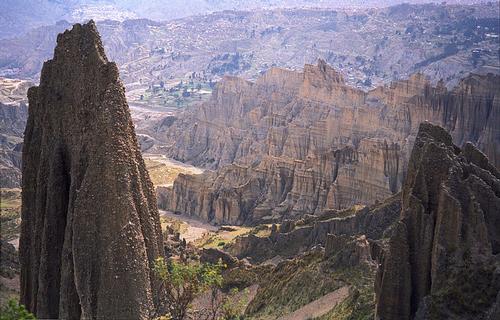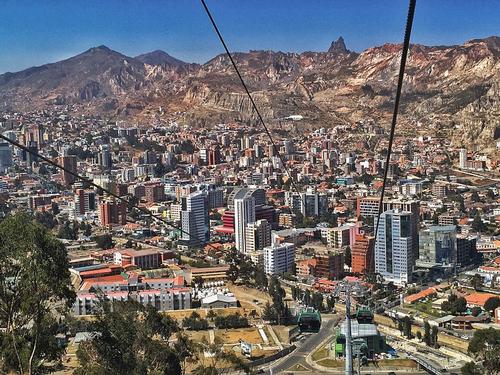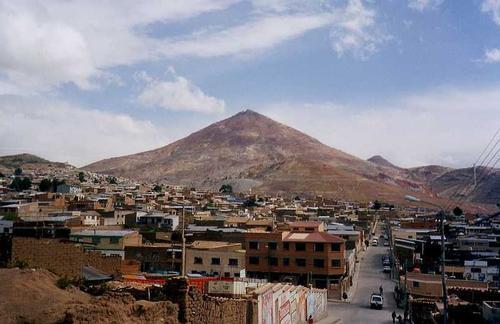BOLIVIA
Vacations and Sightseeing

Vacations and Sightseeing
| Basic information | |
| Official language | Spanish, Quechua, Aymara, Guaraní |
| Capital | Sucre |
| Area | 1.098.581 km² |
| Population | 11,832,940 (2021) |
| Currency | boliviano (BOB) |
| Web | .bo |
| Code. | BOL |
| Tel. | +591 |

Vacations and Sightseeing
 Bolivia Pristine LandscapePhoto: Guttorm Flatabø CC 2.0 Generic no changes made
Bolivia Pristine LandscapePhoto: Guttorm Flatabø CC 2.0 Generic no changes made
Bolivia has not yet been discovered as a holiday destination by mass tourism, despite its beautiful nature with snowy mountains, rugged landscapes, vast savannah areas, swamps, volcanoes, geysers and tropical rainforests. Bolivia also has a largely authentic Indian population (especially of the Aymara and Quecha tribe) and beautiful historic cities. The costumes of the Bolivians are world famous, each province and even each valley has its own models and colors.
 La Paz BoliviaPhoto: Russland345 CC 4.0 International no changes made
La Paz BoliviaPhoto: Russland345 CC 4.0 International no changes made
The city of La Paz, located at an altitude of nearly 4000 meters, where the government resides, has many museums, churches (including the Nuestra Señora de la Paz cathedral built in 1835), the witch market (Mercado de Hechicería) with very special herbs, medicine men and ingredients to influence good and bad spirits, the flower market, the Maeca Negro, the highest ski lift and the highest ski resort in the world, Chacaltaya, and the remains of Tiwanaku (formerly Tiahuanaco). Tiwanaku was the capital of a powerful pre-Hispanic empire that peaked in 500-900. The Museo Nacional de Arquelogía shows the history of Bolivia on the basis of, among other things, a mummy collection and relics from the Tiwanaku culture. The Museo de la Coca is special, where the role of coca leaves in Bolivian culture is brought to the fore. Museo Nacional de Arte provides an overview of Bolivian art history.
Adventurous tourists can push their limits as they brave the descent of the northern Yungasweg (Most dangerous road in the world, El Camino de la Muerte, Death Road), which starts at an altitude of 4,700 meters and ends after five hours and 64 kilometers at an altitude of 1100 meters, and along dangerously deep precipices but also breathtaking views. For mountaineers, the three-day trek to the top of Huayna Potosí is a challenge. On the border of Bolivia and Peru is South America's second largest lake, Lake Titicaca. Salar de Uyuni is the largest salt flat in the world (12,000 km2).

In the city of Potosí, said to be the highest city in the world and a UNESCO World Heritage Site for its history and well-preserved colonial architecture, one can descend into a silver mine.
Nature lovers can visit the Noel Kempff Merchado National Parks, located in one of the most biodiverse areas in the world, Amboró and Madidi.
The legal capital of Bolivia, Sucre has an Old Town that is a UNESCO World Heritage Site as the best preserved Spanish colonial city in South America. The city has many white buildings that explain the nickname 'La Ciudad Blanca'. Worth to visit are the Santo Domingo Church, San Francisco Church, San Lázaro Church, La Recoleta Franciscan Monastery and Bolivar Park. Interesting museums in the capital include the Museum of Modern Art, the anthropological museum Museo Antropológico, which contains hundreds of pieces and artifacts from the period 1200 BC. until the 15th century, and Museo Textil Etnográfico ASUR, with many traditional Bolivian clothing.
Every Sunday, the city of Tarabuco hosts one of the most colorful markets in all of South America.
Sources
Bijl, Y. van der / Reishandboek Bolivia
Elmar
Lindert, P. van / Bolivia : mensen, politiek, economie, cultuur
Novib
Schimmel, K. / Bolivia
Chelsea House Publishers
Sprey, J. / Bolivia
Gottmer
Te gast in Bolivia
Informatie Verre Reizen
CIA - World Factbook
BBC - Country Profiles
Copyright: Team The World of Info